The Rise of the Electric Vehicle during the Covid-19 Pandemic

The Covid-19 Pandemic has caused and continues to cause massive financial challenges globally within the automobile manufacturing sector. This in turn, has caused a sharp decline in demand of all types of vehicles. What has become apparent, however, in the last 12 months or so is the rise of the battery powered electric vehicle (EV) together with plug-in hybrid EV. The uptick and demand for EV appears to be increasing and this has been caused in part by the changing developments of the traditional motor manufacturers and how they are being sold as the new alternative to fossil fueled vehicles.
No doubt about it the Global Pandemic has been tough on many industries, not least the motor manufacturers. On the upside, the pandemic has been, in many ways, the catalyst for change. People travel less to their place of business, if at all. The majority of face-to-face meetings are now conducted online. This has resulted in the realisation that business can be carried out effectively without an immediate face-to-face meet that was so often the norm pre-2020. It is now widespread practice for people to be working from home, creating a reduced demand for the use of both public and private transport and within the private sector, the decrease in the reliance of the fossil fuelled powered vehicle.
The global economy has taken a nosedive and recovery will take many, many years and will result in a hike in global taxation. Recovery has begun in most industries some slower than others. Not surprisingly, recovery has been strong in the EV sector and not in the traditional fossil fuelled vehicles. Even with the low oil prices (today the price of a barrel of crude oil is approximately $30 from a high of about 8 months ago of $60.00), this has not evidenced an increase in the uptake of the purchasing of new petrol or diesel powered vehicles.
What we are seeing now is the increase in the purchase of EVs on both lease and hire. The gentle sway towards EV was evident pre-pandemic, some countries more than others, but the hiatus in global car sales has kickstarted the industry and has prompted Governments to begin thinking more seriously about the cross-over. This increased demand in the global use of the EV is, in part, stimulated by government-led programs and purchase price subsidies, In many European countries, China and the US, the tax benefits for the business user have also been a stimulus for the move towards EVs. All this together with, for example, Europeans strict targets for CO2 emissions have increased the need for a sensible alternative to the petrol-powered vehicles. Finally, perhaps, the general desire for the private user to be that bit “greener”.
The pandemic has brought about this change and a change in people’s perspective in their day-to-day operations. This personal perspective may have been the tipping point. People’s view on the planet. We all saw, and many experienced, the benefits of the reduction of carbon emissions that were experienced during 2020. This appears to have translated into people’s thought processes, and the feeling towards the EV traditionally was that it was perceived to be too expensive, but most of all, the fear of being left stranded without power.
Globally in the last 8 months or so there has been a large increase in the number of EVs being offered for short term hire with no upfront cost. The traditional way of purchasing a vehicle through a dealership has changed significantly as a result of the global pandemic. Dealerships have begun to sell their vehicles online and more emphasis is being made of the Broker who in turn has switched their attention to online sales without any interaction with the customer. In Europe in particular, there has been a proliferation of online vehicle hire companies. These offer an array of EVs from the major manufacturers on a flat monthly fee, no upfront cost, insurance and a good monthly mileage allowance included with the vehicle which is delivered to your door. This new type of ownership is only set to expand. The traditional 1, 2 or 3 year business or personal leases, with large deposits paid up front will soon be outdated.
The cause of the uptake in EVs in Europe has, most likely, been fuelled by the traditional vehicle manufacturers, and the looming emission regulations which are very much on the horizon. This in turn has caused a jump in choice of EVs for the customer. There has been a positive commitment to the buying public, of the new generation battery powered EVs and plug-in hybrid EV models. It has been estimated that the electric vehicle market in Europe is set to expand further. From a market share in 2019 of approximately 1%, it is forecast to be over 4% by the end of this year. In the latter part of 2020, there were over 50 new EV models launched. 2021 will be no different.
It is expected that the vehicle market will continue to recover quickly, but with the EV market share increasing to almost 15% of all new vehicles registered in Europe, it will be EV or hybrid dominant by 2024. A significant uptick from three years ago, when it was barely 1%. There are, of course, global differences within the EV share. China and the US have always led the market in EVs. In the US, for example the EV market share has in fact decreased since 2019. This decrease has been caused by many of the manufacturers cancelling the development of their EV vehicles until the start of 2022. It is expected there will be an increase in market share of the EV and in China the growth has been steady. There are many EV models manufactured that do not leave mainland China.
The common denominator within all markets, is how the EV is being marketed. Already mentioned is the typical lease of a vehicle changing significantly from the traditional business lease, tying you in for a fixed term with a hefty deposit, to a simple rental that can be offset against your tax liabilities.
Telematics has always had a role to play in the leasing of vehicles from simply keeping tabs on the monthly mileage and alerting by exception, to the more robust actions where the vehicle is safely disabled in the event of a fundamental breach of the lease. Telematics also has a significant role to play in the EV rental sector. The simple unit in conjunction with smart phone applications, IOT/Cloud referencing, allows the end user to access the car they need for a set period, be it hours, weeks or months. Not only is a telematics unit required to enter and exit the vehicle, but the supplier retains information on the vehicle’s whereabouts, the state of the battery, and a host of other vehicle related data. The ease at which a user platform and application can be developed has also triggered a rise in the competition of EV car hire for these short periods, with an end user easily switching to another vehicle if so desired.
Currently the rise of the EV will be fettered by the countries development and roll out of the charging network. This has been a major stumbling block for any country wanting to develop the EV. On the one hand, the Governments are pushing and subsidising the sales of electric vehicles, but on the other, it is still very reliant upon the duties that are raised from the sale of fossil fuel. A balance will need to be met and this will be particularly tough given the pandemic the globe is slowly recovering from. There needs to be further major investment in Europe, US, China and others, if we are to be making serious changes to the way business and the public view the EV vehicle. For the general public to have confidence in the EV market this must happen fast. Until then, the market share is unlikely to ever exceed 20%.
There have been great strides made by the traditional carmakers, and with this, the public feel more at ease with the notion of using an EV. On the market, Tesla for example, has been viewed as a pioneer, however, by many it is still viewed as a software company assembling vehicles. This is not to say that they have not gained a march on the competition, particularly in the US and Europe where they have invested heavily in their own charging points. Now that the major manufacturers are gearing up towards large scale investment of the EV, Tesla will find it more and more difficult to compete. The large-scale manufacturers, who have been building vehicles with the requisite build quality for decades have that distinct advantage, and now that they are finally investing heavily in EV technology, companies such as Tesla are losing ground. There may be a sticking point for a few more years yet, and the amount of investment governments grant, to establish the EV charging networks. This is something Tesla don’t have to do. With the purse strings drawn tight around the globe caused by the pandemic, investment in the charging networks may be slowed.
As an aside most, if not all, of the traditional car manufacturers are stalling to embrace the full EV, rather preferring to develop Hybrids alongside the full EV. The in-country legislation which sets out the timelines when all vehicles need to be an EV by a date include Hybrids as an EV. Having a vehicle that will run for 15 miles on electric before reverting to fossil fuel is nonsensical and only delays the inevitable. Governments who have legislated in this way have clearly missed the point.
Let us hope that we do not all rush back into fossil fuel but utilize the last 18 months as a huge steppingstone to great and greener business operations.
Author:

Myles McNulty
IOT Connected Vehicles
Myles McNulty is Owner and VP of IOT Connected Vehicles, a Consultancy he started in 2019 advising organisations on the role of Telemetry and associated applications. Being an independent consultant, he has been working in the field of Telematics, IOT, SaaS and Connected Vehicles for over 20 years. He has spoken widely on the benefits of telematics and the connected vehicle at conferences in EMEA, US and China. He lives close to Milton Keynes UK a city that has seen testing and trials of many autonomous cars during the last 30 years.
Published in Telematics Wire



